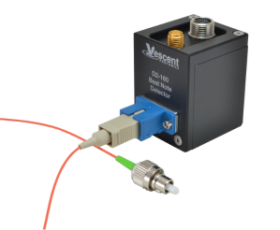Table of Contents
D2-260 High-Speed Beat Note Detector
Model No. D2-260
Document Revision: 1
Document Last Updated on 2021/08/26 14:26
Please read Limited Warranty and General Warnings and Cautions prior to operating the D2-260. All specifications subject to change without notice.
Description
The Vescent Photonics D2-260 high-speed detector has a full 9.3 GHz bandwidth for capturing beat notes between lasers of different frequencies. Simply overlap the master and slave lasers and launch into the included multimode fiber for measuring the relative frequencies of the two lasers. The D2-260 is compatible with both the Vescent D2-150 Heterodyne Module and the D2-135 Offset Phase Lock Servo. In combination, a true phase lock between a pair of lasers with a user-defined frequency offset can be established. The D2-260 is also compatible with the new ICETM (Integrated Control Electronics) architecture. The D2-260 can also capture fast rising edges of laser pulses for timing, triggering, and pulse synchronization.This digitizing high-speed pre-amplified detector converts an oscillating optical signal (a beat note) into an electrical high/low signal. It works great for measuring beat note frequencies or high-speed timing. It is not suitable for measuring optical power or other amplitude characteristics due to the digitized output.
Purchase Includes
- D2-260 Beat Note Detector
- 18 GHz RF SMA Cable (6 ft)
- VPN00460 FC/APC to LC MM patch cord (6 ft)
Also look for:
- VPN00410 Hirose-to-D Sub 9-pin (for use with D2 products) or
- VPN00475 Hirose-to-Hirose power cord (for use with ICE products)
Absolute Maximum Ratings
Note: All modules designed to be operated in laboratory environment
| Parameter | Rating |
| Environmental Temperature | >15°C and <30°C |
| Environmental Humidity | <60% |
| Environmental Dew Points | <15°C |
Specifications
| Value | Units | |
|---|---|---|
| Input Type | SC multimode fiber or free space | |
| Wavelength Response | 770 ≤ λ ≤ 855 | nm |
| Bandwidth | 0.25 to >9.3 | GHz |
| Input Power Range1) | 50 minimum 200 optimal | μW |
| Output Connection | SMA | |
| Pulse Rise Time | <25 | ps |
| Power Requirements | +5V (pin 4), GND (pin 6) | Hirose |
| For Hirose to DB9 Power Cable | +5V (pin 4 on Hirose to pins 6 & 7 on DB9), GND (pin 6 on Hirose to pins 1 & 2 on DB9) | Hirose |
| Dimensions | 1.38 x 1.25 x ~1.7 | inches |
__
Operating Instructions
Do not put more the 1 mW of optical power into the D2-260, as this can damage the device.
Powering the D2-260
Never connect this device to a power supply that is switched on and supplying power. Always turn off the power supply, make connections to this device, and then re-energize the power supply.
The D2-260 requires +5 VDC and ground to operate. The power input is via a female 6-pin Hirose connector HR10A-7TR-6SA(73). If you are making your own power cable, pin 4 is +5 V and pin 6 is ground. Use a 6-pin male Hirose connector HR10A-7TP-6P(73). Depending on your order configuration, you should have received a power cable with this connector on one end and either the same on the other (typically for using with ICE products) or a DB-9 connector (with D2-products).
If you are using the supplied DB9-to-Hirose cable, but not a Vescent D2-005 power supply, the table above details which pins on the DB9 require which voltages. The figure below may be useful.
Detector Description
Unlike high-speed analog photo-detectors, the output of the D2-260 is not proportional to the input signal strength. The output of the D2-260 is digitized, which makes its output largely independent of the input signal strength. You cannot use the output to calculate the input power. The output is CML, which will have a DC output value of ~2.8V both with and without input signal. The best way to look at the output from the D2-260 is on a spectrum analyzer (or with the D2-135). Take care you put a DC-block in front of the spectrum analyzer as the D2-260 outputs a DC voltage. On the spectrum analyzer, you will be able to see the spectrum of the optical beat-note input into the detector.
Because the D2-260 uses multi-mode fiber, it is possible to couple light from two lasers into the fiber, but not have the two laser beams overlapped in the fiber and thus producing a weak (or no) beat note form the D2-260. If you are not seeing a beat note from the D2-260, please check the following:
- The input polarization of two input lasers is the same when coupled into the fiber
- The two laser inputs at the fiber are spatially overlapped (check that they are well overlapped at two distant points)
- The lasers are close (<10 GHz) in frequency, so they produce a beat note within the range of the detector. Make sure they are at least 250 MHz apart.
- The D2-260 is properly powered, as indicated by blue power LED being on.
Mounting
Although the D2-260 does not need to be mounted as its inputs and outputs are flexible cables and fiber, the bottom of the D2-260 contains a threaded 8-32 and M4 holes for mounting.


